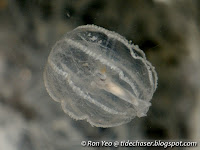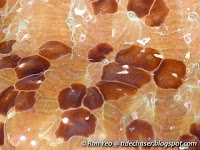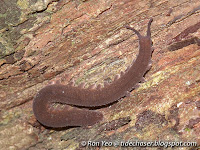A quick look at some of the organisms that can be found in Singapore! Will update with more organisms and information as and when I have the time! :)
A) FAUNA OF SINGAPORE
Here are some of Singapore's fauna that I have seen and photographed so far...
B) FLORA OF SINGAPORE
Kindly note the plant guides below can only be used in Singapore, as the same species may have different morphological features in other places.
A) FAUNA OF SINGAPORE
Here are some of Singapore's fauna that I have seen and photographed so far...
| 1. Sponges (Phylum Porifera) | |

| Sponges are very simple multicellular animals with no true tissue and organ. They also have no body symmetry, and are just congregation of several types of cells which form an organised structure with numerous pores and channels for the circulation of water. |
| 2. Comb Jellies (Phylum Ctenophora) | |
 |
Comb jellies are mostly free-swimming organisms that appear like jellyfish with eight strips running down the length of their bodies. Others creep over the substrate, resembling flatworms. Many comb jellies possess a pair of tentacles fringed with smaller tentacles. |
| 3. Cnidarians (Phylum Cnidaria) | |
 |
Cnidarians are radially symmetrical animals with tentacles that possess explosive, harpoon-like cells (cnidocytes). Examples include sea anemones, tube anemones, corallimorphs, hard corals, zoanthids, soft corals, blue corals, sea pens, hydroids, and jellyfish. |
| 4. Horseshoe Worm (Phylum Phoronida) | |

| Horseshoe worms are marine worms living in tubes and have a crown of tentacles arranged in a somewhat horseshoe shape if viewed from the top. One species, the Black Horseshoe Worm (Phoronis australis) which lives with tube anemones, can be seen in Singapore. |
| 5. Moss Animals (Phylum Bryozoa) | |

| Bryozoans are tiny organisms that mostly live in colonies (except for one solitary species). Each individual bryozoan animal has a lophophore, which is a crown of tentacles for filter feeding, and lives in a chitinous or calcareous chamber-like exoskeleton (or zooecium). |
| 6. Lamp Shells (Phylum Brachiopoda) | |

| Brachiopods, or lamp shells, are solitary, clam-like animals with a two-part shell. Unlike a clam which has a left valve and a right valve (based on how the valves are oriented to the body), a lamp shell has a dorsal (or "upper") valve and a ventral (or "lower") valve. |
| 7. Acoel Worms (Phylum Acoelomorpha) | |

| The acoels are flat, bilaterally symmetric, soft-bodied unsegmented worms typically found in the marine environment. They do not have a gut cavity, and have a distinctive balance sensory receptor (made up of a large cell bearing a calcareous body) at the front end. |
| 8. Echinoderms (Phylum Echinodermata) | |
 |
Echinoderms are marine animals with penta-radial symmetry, i.e. each echinoderm can be divided into 5 equal parts, at least in some stage of life. They include the various species of sea stars, feather stars, brittle stars, sea cucumbers, sea urchins and sand dollars. |
| 9. Hemichordates (Phylum Hemichordata) | |
 |
Hemichordates are worm-like animals characterised by a three-part body - the front end, followed by a collar, and a posterior trunk. There is a flexible, hollow tube (the stomochord) in the collar region, somewhat resembling the notochord found in chordates. |
| 10. Annelid Worms (Phylum Annelida) | |

| Annelids are bilaterally symmetrical worms which may or may not be segmented. The segmented annelids will have a body comprising identical segments. Recent studies have shown that unsegmented worms such as the spoon worms and peanut worms are also annelids. |
| 11. Ribbon Worms (Phylum Nemertea) | |

| Ribbon worms are soft-bodied, bilaterally symmetrical animals that are mostly long, thin and flat (like a ribbon). Some species, however, have short and wide bodies. They have an eversible proboscis which can shoot out just above the mouth to capture/retrieve their food. |
| 12. Flatworms (Phylum Platyhelminthes) | |
 |
Flatworms are unsegmented worms with soft and bilaterally symmetrical bodies. They are mostly very flat, and hence the common name "flatworm". While many flatworms are parasites of other animals, we can still see many pretty free-living flatworms on our shores and forests. |
| 13. Velvet Worms (Phylum Onychophora) | |
 |
Velvet worms are segmented, centipede-like organisms with numerous pairs of walking legs. Each leg has a pair of claws. They lack a rigid exoskeleton, and instead, the body cavity is filled with a fluid to make them firm. They hunt small invertebrates with a glue-like slime. |
| 14. Arthropods (Phylum Arthropoda) | |

|
Arthropods have segmented bodies, jointed limbs, and external skeletons. They need to moult as they develop. Examples include millipedes, centipedes, symphylans, horseshoe crabs, arachnids, sea spiders, insects, springtails, malacostracans and barnacles. |
| 15. Molluscs (Phylum Mollusca) | |

|
Molluscs are soft-bodied animals. Most species have shells (can be very reduced), a mantle, a muscular foot and a radula. Examples include chitons, tusk shells, cephalopods, gastropods (marine snails, marine slugs, non marine gastropods) and bivalves. |
| 16. Chordates (Phylum Chordata) | |

| Chordates are characterised by having a nerve cord within a flexible rod-shaped structure called a notochord in their body. Examples include the tunicates, cartilaginous fishes, ray-finned fishes (marine and freshwater), amphibians, reptiles, birds and mammals. |
B) FLORA OF SINGAPORE
Kindly note the plant guides below can only be used in Singapore, as the same species may have different morphological features in other places.
| 1. True Mangrove Plants | |
 |
True mangrove species refer to those that grow only in mangrove environment. They are adapted to survive in saline, waterlogged and anaerobic conditions. Based on Tomlinson’s list, Singapore has 30 true mangrove species, and here's an ID key that I have developed to identify them. |
| 2. Coastal Shrubs & Trees (with Simple Leaves) | |
 |
These plants have simple leaves, i.e. leaves that are not divided into leaflets. They may have opposite leaves, alternate leaves, or spirally arranged leaves (especially in monocot plants). Sometimes, the leaves are so reduced that it is hard to determine the arrangement. |
| 3. Coastal Shrubs & Trees (with Compound Leaves) | |
 |
These plants have each of their leaves fully subdivided into leaflets. Compound leaves can be differentiated from simple leaves by identifying where the petiole (the leaf stalk attaching the leaf to the stem) occurs. A new compound leaf also occurs as one with many small new leaflets. |
| 4. Coastal Creepers & Climbers | |
 |
The creepers and climbers featured here refer to plants with long and narrow stem that spread over the ground and lower structures (i.e. creepers) and those that climbing onto taller structures and trees (i.e. climbers), but exclude the grasses and grass-like plants. |
| 5. Coastal Epiphytes, Ferns & Ground-dwelling Herbs | |
 |
An epiphyte is a plant that grows upon another plant. True epiphytes do not derive nutrients from the host plant, unlike parasitic epiphytes. Ferns are vascular plants which do not produce seeds but reproduce via spores. Herbs are flowering plant with no persistent woody stems. |
| 6. Mistletoes of Singapore | |
 |
Mistletoes are obligate hemiparasitic shrubs from the order Santalales. They have modified roots called "haustoria" which penetrate into the host plants' tissues to draw water and non-organic nutrients, but are able to photosynthesize to produce their own sugar. |

8 comments:
these are great resources. thanks for posting them up.
Thanks Eunice!
Thanks a lot, this article very helpful..
Thanks a lot, this article very helpful..
Great blog! Keep it going.
Great Blog Ron!
Thanks!
It's certainly informative for nature lovers like us. Thanks Ron and please continue the good work!
Post a Comment